

What Do Phytochemicals Do for Your Health? Unfortunately, plants have become the latest foods to be demonized in the integrative health community, primarily due to the growing influence of outspoken carnivore diet advocates.
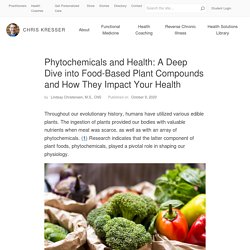
While humans may prefer meat and fat, phytochemical-rich plant foods are a natural part of our omnivorous diet and offer us numerous health benefits. Read on to learn about the myriad health benefits of phytochemicals, the foods in which these substances can be found, and specific situations in which phytochemicals may act as a double-edged sword. Many advocates of the carnivore diet say that phytochemicals are harmful for your health—but that’s not the whole story.
Check out this article from nutritionist Lindsay Christensen for an in-depth look at the role phytochemicals play in your health. #paleo #nutrition #wellness Phytochemicals: An Evolutionary Perspective It turns out that, throughout our history, we humans have evolved to experience certain health benefits through the consumption of plants. 1. 2. 25 Foods High In Antioxidants, Ranked By Actual Measurements. Contents [hide] The fact is that the best sources are often different than what’s being marketed to you at the grocery store or juicery.
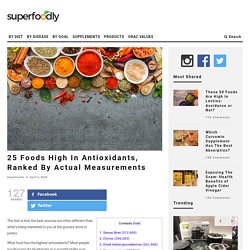
What food has the highest antioxidants? 15 Highest Antioxidant Berries (Hint: Not Goji) Contents [hide] Not to say they’re useless, but some of the most hyped superfoods have the least amount of research.
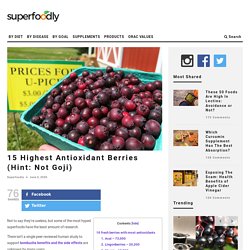
There isn’t a single peer-reviewed human study to support kombucha benefits and the side effects are unknown by many users. What is dragon fruit good for? Very little antioxidant activity, trivial vitamin and mineral content, and there aren’t clinical studies. The benefits are highly exaggerated. On the flip side, some of the most deserving superfoods are ignored.
Astaxanthin. Flavanoids. PQQ. Resveratrol and Pterostilbene. The total antioxidant content of more than 3100 foods, beverages, spices, herbs and supplements used worldwide. With this study we present a comprehensive survey of the total antioxidant capacity in foods.
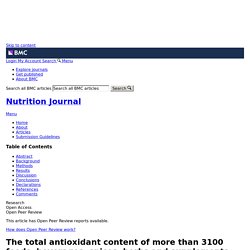
Earlier small-scale studies from other laboratories have included from a few up to a few hundred samples [20, 21, 22, 29, 30, 31], and in 2007 the U.S. Department of Agriculture presented the Oxygen Radical Absorbance Capacity (ORAC) of Selected Foods report including 277 food samples [23]. These studies have been done using different antioxidant assays for measuring antioxidant capacity making it difficult to compare whole lists of foods, products and product categories. 4 Polyphenol-Rich Foods to Eat Every Day. Is Broccoli Good for You? Meet the Crucifer Family... - Diagnosis:Diet. Public health officials and nutrition experts love to sing the praises of the virtuous cruciferous vegetable family.

We are told that these pungent plants can fight off cancer, strengthen our immune system, and leap tall buildings in a single bound. But could crucifers have a dark side? The cruciferous veggies (the Brassica family) dominate the produce aisle; many people may not realize how many familiar vegetables belong to this family. Beyond the ORAC Score: Why a Variety of Antioxidants Is Important. Antioxidant is a seemingly ubiquitous word used on many websites and in multiple contexts, but what is it exactly?

In simple terms, an antioxidant is a molecule that prevents the oxidization of other molecules. Oxidization leads to the formation of free radicals, which eventually cause cell death or damage. Antioxidants slow the effects of age-related degeneration and disease; however, not all antioxidants are created equally. One way of comparing them is through their ORAC (oxygen radical absorbance capacity) value. The Antioxidant Myth. Antioxidant Hopes and Dreams Source: Marilyn Barbone/123RF Do you choose colorful vegetables, fruits and fruit juices in hopes that their antioxidants will destroy free radicals and fight inflammation?
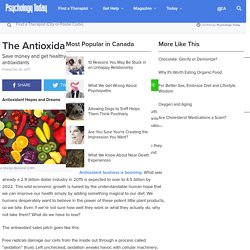
Do you take expensive antioxidant supplements or plant extracts because they promise to help you ward off cancer and slow aging? Antioxidant business is booming. 25 Foods High In Antioxidants, Ranked By Actual Measurements. The 15+ Benefits of Broccoli Sprouts And Sulforaphane (And How To Prepare Them) Sulforaphane inhibits the proliferation of synovial fibroblasts, the expression of MMPs and COX-2, and the production of PGE2, which are involved in synovitis and destruction of Rheumatoid Arthritis.

R. 100 Quercetin Foods: Best Natural Sources Ranked. Resveratrol is what’s known as a sirtuin-activating compounds (STAC).

These influence sirtuins. In plain English, they slows down cell aging. A lesser discussed STAC is quercetin. We will cut right to the chase and tell you the highest source… it’s capers. Number one is for fresh capers and even when jarred, they still take the silver medal. The problem? These are flower buds from the Mediterranean. Do Broccoli Sprout Supplements With Sulforaphane Work? As a youngin, your mom may have muttered to eat your broccoli.
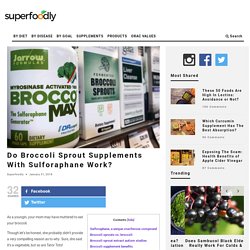
Though let’s be honest, she probably didn’t provide a very compelling reason as to why. Sure, she said it’s a vegetable, but so are Tator Tots! Only recently have scientists uncovered the most compelling reasons as to why we should eat it. Sulforaphane, a unique cruciferous compound Broccoli, Brussels sprouts, kale, and other cruciferous vegetables contain glucosinolates. 40 Purple Vegetables & Fruits Ranked By Antioxidant Content. Do Polyphenols Improve Your Gut Bacteria? Polyphenols & Health.
7 Lycopene Benefits that Fight Disease & Improve Cognition. Health Hack #7: Maximise your phytonutrients – Rosemary Cottage Clinic Blog. 15 Highest Antioxidant Berries (Hint: Not Goji) Humble but Powerful: Cruciferous Vegetables Detoxify via a Potent Molecule Called DIM - Blog.